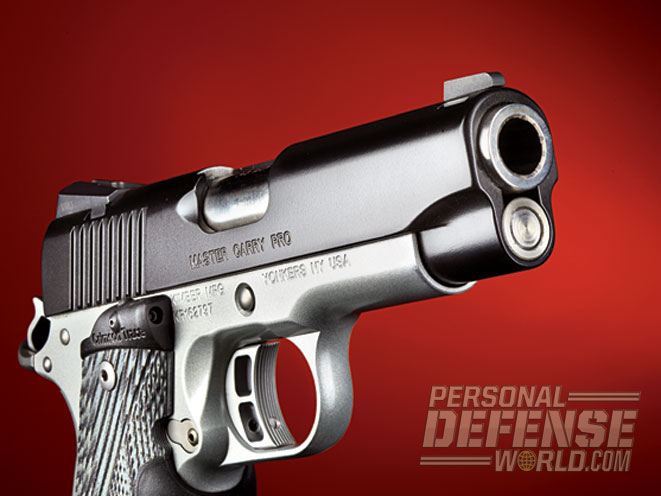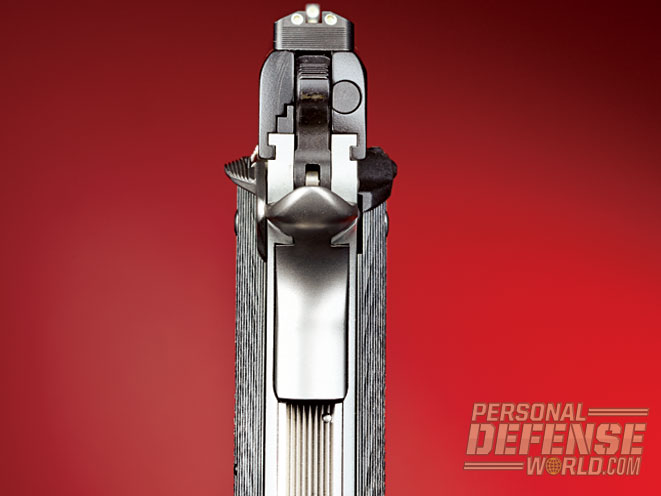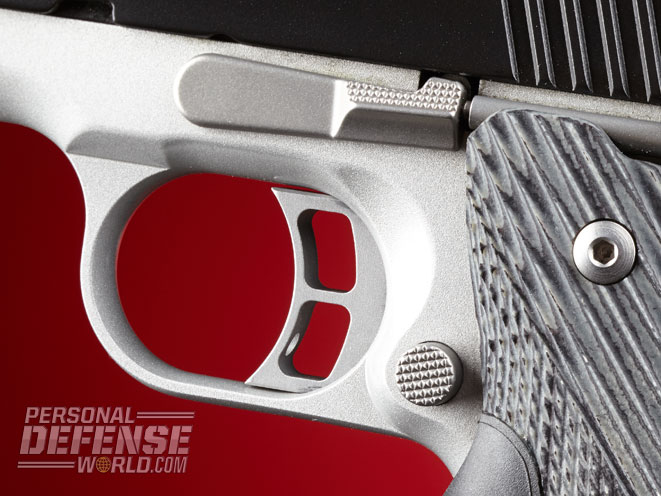For those who enjoy a good 1911, the name Kimber is well known, and for good reason. During the 1911 doldrums of the late 1970s and early 1980s, the sole purveyor of the 1911 pistol was essentially Colt Manufacturing, which had produced 1911s for the military, law enforcement and law-abiding citizens since, well, 1911.
By 1979, Colt was offering a few variants to the 1911, including its Commander, Lightweight Commander and Gold Cup models, but innovation was a little on the slow side and Colt seemed to be focused on its AR-15/M16 production. The supply of “Old Slab-Sides” was tight and relatively expensive. Through the efforts of Colonel Jeff Cooper and the mainly 1911-based competition he introduced to the world, the International Practical Shooting Confederation, demand was on the rise.
In 1979, Greg and Jack Warne of Oregon did something that would shake all that up—founding Kimber of Oregon (now Kimber Manufacturing). And as they say, the rest is history. Today, Kimber offers a huge variety of 1911s as well as a number of sporting and tactical rifles.
Advertisement — Continue Reading Below
Meet The Master

The Kimber Master Carry Pro bears a distinct familial resemblance to the Lightweight Commander of Colt fame, a model viewed as the perfect carry gun by many serious and knowledgeable 1911 users, including Col. Cooper, with its shorter barrel and full-sized frame of aircraft-grade aluminum alloy. Cooper felt the Lightweight Commander achieved great portability without sacrificing performance or reliability.
RELATED: Gun Review – Kimber’s Compact Defenders
Advertisement — Continue Reading Below
The .45 ACP Master Carry Pro is not a clone of the original Commanders. Kimber designed its Master Carry Pro using a 4-inch barrel/slide, which many feel makes for better drawing and concealing compared to a full-size 1911.
A match-grade, stainless steel bull/cone barrel is mated directly to the abbreviated stainless steel slide and uses a full-length recoil spring guide rod inside the 22-pound recoil spring. The slide is coated black with KimPro II, a polymer finish Kimber describes as “tough and self-lubricating” and which “offers outstanding resistance to chemicals, moisture, salt and UV light.” Of all the properties listed, the self-lubricating feature may be the most important as it provides a smoother-running slide.

The perfectly executed lowered and flared ejection port can add a margin of reliability. Generous slide cocking serrations are found only on the rear of the slide. Low-profile Tactical Wedge sights, complete with a three-dot tritium system, ride the pistol’s top.
Advertisement — Continue Reading Below
RELATED: Kimber’s PepperBlaster II Delivers Threat-Stopping Pepper Gel | Video
In keeping with the “easier to carry” theme, the full-length Master Carry Pro frame is machined from a block of lightweight 7075 T-6 aluminum alloy with a satin silver KimPro II finish on the surface. The hammer is an elongated burr (Commander style) that works well with the high-ride beavertail. Kimber’s backstrap is vertically serrated and ends in the company’s “Round Heel” design. This removal of the sharp rear edge of the mainspring housing and magazine well does make a difference in the concealability of the pistol, and I’ve found the contour actually improves how the pistol feels in my hands.
A long, aluminum, skeletonized trigger, complete with overtravel adjustment, works with the hammer to produce a trigger pull weight of a crisp 4.6 pounds, which is not bad for a production pistol. The thumb safety is extended and slightly widened, all without making it cumbersome. Kimber’s magazine release is slightly extended compared to traditional versions. However, all my 1911s have the same extended magazine release and they have never caused a single problem after years of carry.
Advertisement — Continue Reading Below

A recessed slide stop shaft and really nice looking Crimson Trace Master Series G10 Lasergrips complete the frame. Crimson Trace’s Lasergrips are standard thickness and length, secured with stainless hex screws and have the lower rear corners contoured to match the Kimber Round Heel frame. Recessing the slide stop shaft eliminates possible interference with the laser beam.
Crimson Trace describes the system used to initiate its laser as Instinctive Activation, which “means that when you hold your gun in a normal firing grip, the laser is on. When you holster or disengage your grip, the laser turns off.” A rubber-coated pressure switch, positioned perfectly for the middle finger to activate it, runs across the frontstrap, connecting the grip panels. With pressure, the red laser blasts out, factory sighted for 50 feet.
With all the Kimber Master Carry Pro’s excellent attributes, it still comes in at a svelte 28 ounces with an empty magazine. Compare this to a full-size, all-steel 1911 sans Lasergrip and the Master Carry Pro’s 10-ounce weight savings seems pretty significant.
Advertisement — Continue Reading Below
Range Report

I really enjoy testing quality 1911s, with the short single-action (SA) trigger being just one of the reasons. Kimber’s Master Carry Pro did not disappoint.
RELATED: Kimber’s Ultra Raptor II Is An Ultra-Compact Carry Powerhouse
Advertisement — Continue Reading Below
The best five-shot group, produced by Federal’s 165-grain Personal Defense Reduced Recoil FMJ (full metal jacket), checked in at 1.46 inches, with the average of all “best groups” at 1.56 inches. As for average groups, CorBon’s 185-grain +P DPX produced the best, at 1.66 inches. This is excellent performance for any production pistol, and very good for a pistol specifically designed for concealed carry/defensive use.
The lightweight 7075 T-6 aluminum alloy frame is nice for carrying, providing less drag on the belt and pants. I tried to notice any difference between the alloy frame and a steel frame, but not being very recoil sensitive, I really could not decide. Dragging a full-size, all-steel version out and comparing from shot to shot, I could notice a difference. I’ve always felt that the lower mass of the shorter slide, which translates to less momentum, offsets some of the recoil differences. After completing all the shooting, I stripped the Master Carry Pro and examined the frame. There were no indications of wearing problems.
Through several hundred rounds of mixed ammunition, the Kimber functioned perfectly after the first magazine. Within those eight rounds I had one failure to feed, which was never reproduced.
Advertisement — Continue Reading Below

I’m a fan of eight-round magazines in a full-size frame, such as on the Master Carry Pro, and seven-rounders for abbreviated frames. I’ve never had a problem with either combination. Kimber’s stainless steel eight-round KimPro Tac-Mag arrived with a Teflon-coated follower and Rocket wire spring. Three floorplates are included: flat stainless steel, slim and thick bumper pads. I tossed in a number of magazines from other companies into the mix and found that they did not affect the Master Carry Pro’s reliability.
A comment I’ve heard from a few right-handed folks over the years is that they do not like the mount location of the Crimson Trace laser. It seems that they are concerned about their trigger finger, when in register off the trigger, blocking the beam. Of course, none of them had ever tried the Crimson Trace Lasergrips. If the beam is blocked while not shooting, it should be a reminder that the muzzle probably does not need to be on the target. The beam reappears as soon as the shooting sequence begins. Secondly, if you absolutely, positively have to see the laser painting a ne’er-do-well’s chest, lower the finger just a hair.
I found the Lasergrips worked instinctively, popping on immediately when needed, allowing me to see the impact point on the target even while still lining up the sights.
Advertisement — Continue Reading Below
The Takeaway
I was extremely pleased with the performance of the Kimber Master Carry Pro. A 1911 with an instinctively activated laser makes a formidable package. Arriving as the Master Carry Pro did, with all of Kimber’s standard enhancements, the pistol/Crimson Trace Lasergrips provide an excellent choice for shooters wanting a .45 ACP 1911 for everyday carry and defensive use!
This article was originally published in the December 2014 issue of COMBAT HANDGUNS. Subscription is available in print and digital editions below.






































